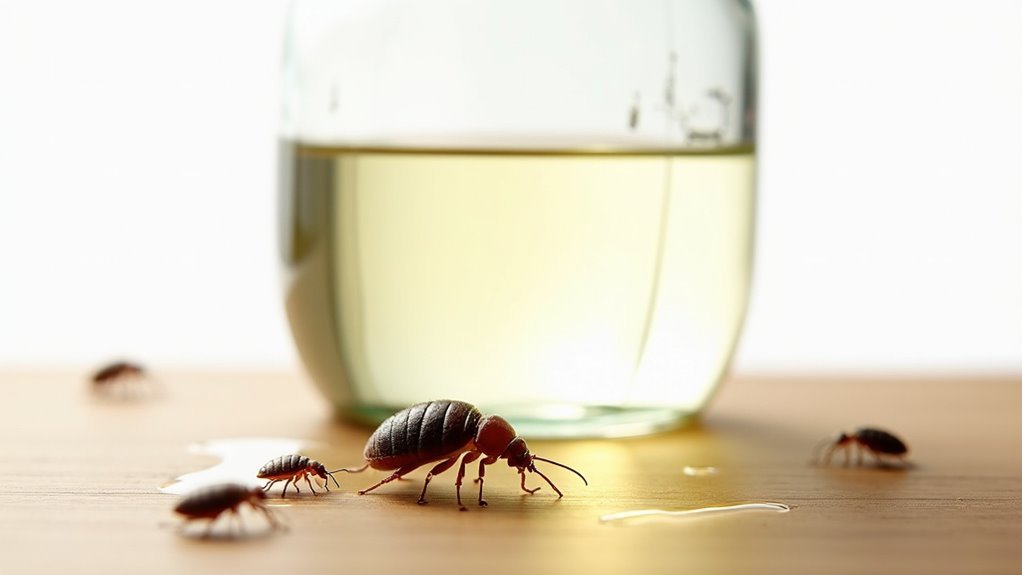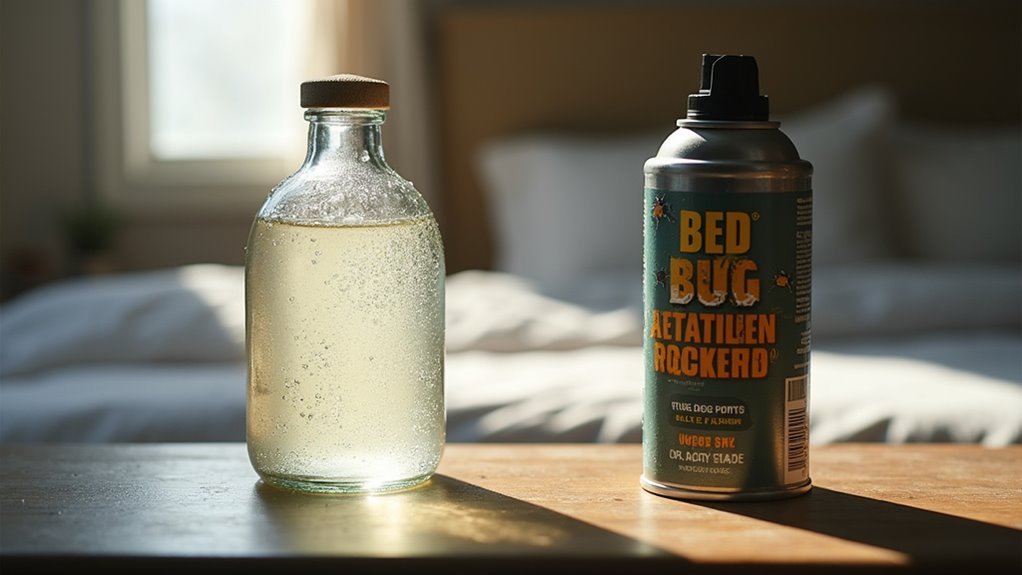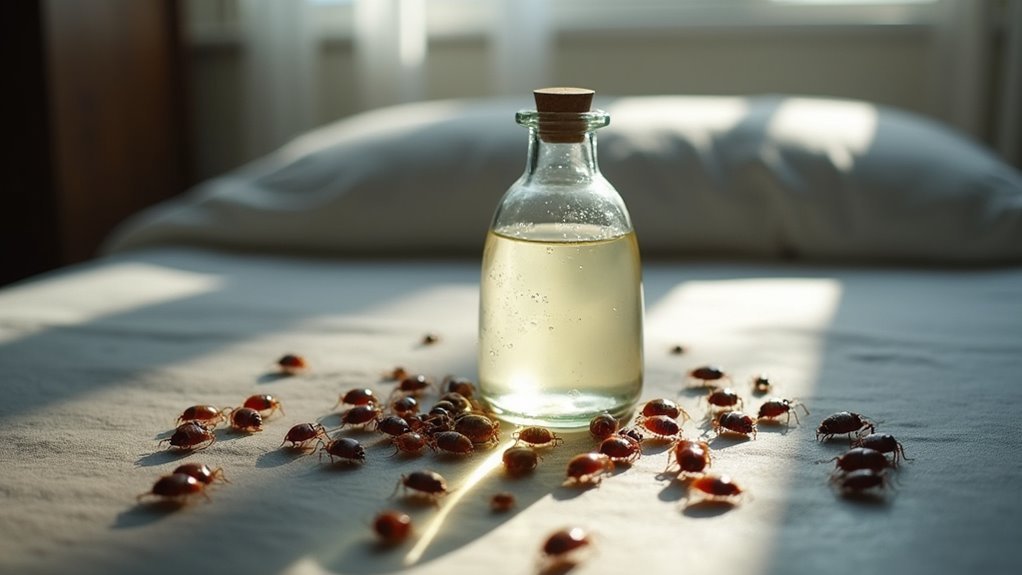Recent laboratory studies show that white distilled vinegar kills approximately 60% of adult bed bugs on direct contact, but you’ll face significant limitations. The 5% acetic acid disrupts their nervous systems within minutes, yet it’s completely ineffective against eggs and provides zero residual protection once it dries. You’ll need to saturate affected areas and repeat applications daily, but vinegar works only as a temporary deterrent. Professional treatments targeting all life stages offer superior long-term solutions for thorough elimination.
How Vinegar’s Acetic Acid Content Affects Bed Bugs

When you spray vinegar directly on bed bugs, its acetic acid content immediately disrupts their nervous system and kills them within minutes. The typical vinegar contains around 2.5 pH levels, making it highly acidic and lethal to adult bed bugs upon contact.
This acetic acid content works by attacking the bugs’ biological functions, causing rapid death when applied directly.
However, vinegar functions as a contact type insecticide, meaning it only works when it physically touches the pests. You won’t get residual protection after application, so you’ll need to spray it repeatedly during infestations.
Vinegar only kills bed bugs through direct contact and provides no lasting protection, requiring repeated applications throughout an infestation.
While vinegar can kill bed bugs effectively on contact, it can’t penetrate the hard egg casings, leaving developing bugs protected. You must target visible adults and their known hiding spots for maximum effectiveness.
Laboratory Testing Results on Vinegar vs. Bed Bugs
You’ll find that laboratory studies reveal striking differences in vinegar’s effectiveness depending on direct contact and acetic acid concentration.
Research shows you can achieve nearly 100% kill rates on adult bed bugs with direct spray application, but the results vary dramatically based on the vinegar’s acid strength.
However, you shouldn’t expect the same success with bed bug eggs, as testing consistently demonstrates their remarkable ability to survive vinegar exposure due to their protective casings.
Direct Contact Kill Rates
Several laboratory studies have tested vinegar’s effectiveness against bed bugs, revealing mixed results that depend heavily on application method and bug life stage.
When you apply white distilled vinegar directly to adult bed bugs, you’ll achieve approximately 60% kill rates within minutes. The vinegar’s acidic properties disrupt their nervous systems, but this effectiveness drops considerably with nymphs and immature bugs.
You’ll find that direct saturation is essential – if the vinegar doesn’t completely cover the bugs, many will survive. The contact must be thorough and immediate since vinegar lacks residual killing properties.
Once it dries, it won’t continue eliminating bugs that weren’t initially exposed. This limitation makes vinegar unreliable for extensive bed bug control, especially in real-world infestations where complete coverage is nearly impossible.
Acetic Acid Concentration Effects
The acetic acid concentration in vinegar directly determines its lethal impact on bed bugs. When you use white distilled vinegar with 5% acetic acid concentration, you’ll achieve peak effectiveness against adult bed bugs upon direct contact.
Laboratory tests confirm that this 5% concentration disrupts the nervous system of bed bugs effectively, causing immediate death when they’re fully saturated with the solution.
Higher acetic acid concentrations don’t greatly improve kill rates, while lower concentrations become less reliable. You’ll find that standard household vinegar already contains the ideal acetic acid level for bed bug elimination.
However, remember that even at 5% concentration, vinegar can’t penetrate bed bug egg casings, limiting its overall effectiveness. The concentration affects only adult and nymph stages, not the reproductive cycle.
Egg Survivability Studies
While vinegar proves lethal to adult bed bugs on contact, laboratory studies reveal a critical weakness in its effectiveness against complete infestations.
Research demonstrates that vinegar’s high acidity can’t penetrate bed bug eggs, allowing them to survive exposure and hatch unscathed. This severely limits vinegar’s effectiveness as a standalone treatment method.
Laboratory testing reveals these critical findings:
- Vinegar kills approximately 60% of adult bed bugs upon direct contact.
- Bed bug eggs remain completely viable after vinegar application.
- Nymphs show resistance similar to eggs during testing.
- Only insects in direct contact experience nervous system disruption.
These studies confirm that while vinegar disrupts adult bed bugs’ nervous systems, it can’t reach hidden populations or eliminate egg clusters, making it primarily useful as a temporary deterrent rather than a thorough eradication solution.
White Distilled Vinegar Application Methods and Safety
When you’re ready to apply white distilled vinegar against bed bugs, you’ll need to master the proper spray bottle technique to guarantee thorough saturation of affected areas.
Before treating any surfaces, you must wear protective goggles and gloves to shield yourself from the acid’s potential irritation.
It’s also essential that you test the vinegar on a small, inconspicuous area first to prevent unexpected damage to fabrics or surfaces.
Proper Spray Bottle Technique
Effective vinegar application requires proper spray bottle technique to maximize bed bug elimination while protecting yourself from potential harm. Fill your spray bottle with undiluted white distilled vinegar for maximum potency. Apply vinegar directly to visible bed bugs and saturate all hiding spots thoroughly to disrupt their nervous system.
Follow these essential safety steps for effective bed bug treatment:
- Wear protective goggles and gloves to prevent acid irritation.
- Test small fabric areas first to avoid discoloration damage.
- Saturate affected areas completely for thorough coverage.
- Repeat applications daily for one week minimum.
Your spray bottle technique determines treatment success. Target crevices, mattress seams, and furniture joints where bed bugs hide.
Persistent daily applications guarantee you reach bugs that initially escape treatment.
Essential Safety Gear Requirements
Protection becomes your first priority when handling white distilled vinegar’s acidic solution for bed bug treatment. Essential safety gear requirements include protective goggles to shield your eyes from the pH 2.5 solution’s acidity. You’ll need chemical-resistant gloves to prevent skin irritation during prolonged contact, especially on sensitive areas.
| Safety Equipment | Purpose | Application Area |
|---|---|---|
| Protective Goggles | Eye protection from acid splashes | Face/Eye region |
| Chemical Gloves | Skin irritation prevention | Hands/Forearms |
| Ventilation Mask | Odor mitigation | Respiratory system |
| Long Sleeves | Extended skin coverage | Arms/Torso |
| Closed Shoes | Foot protection from spills | Feet/Ankles |
Always test white distilled vinegar on small fabric areas before widespread application. Verify proper ventilation to manage lingering odors, and apply carefully to achieve saturation without excessive spillage.
Surface Testing Before Application
Surface compatibility testing prevents costly damage to your belongings during bed bug treatment with white distilled vinegar.
Before treating larger areas affected by bed bugs, you’ll need to confirm that vinegar won’t cause discoloration or damage to your fabrics and surfaces.
Follow these essential surface testing steps:
- Select a small, inconspicuous area on the material you plan to treat.
- Spray the test area with undiluted white distilled vinegar.
- Wait 10-15 minutes to observe any adverse reactions or discoloration.
- Dilute vinegar with water if testing reveals sensitivity on delicate surfaces.
This preliminary application method guarantees you won’t accidentally damage valuable items while eliminating bed bugs.
Always conduct surface testing on each different material type before proceeding with full treatment.
Vinegar’s Impact on Bed Bug Eggs and Larvae
While vinegar can kill adult bed bugs on contact, it faces significant limitations when targeting their eggs and larvae. You’ll find that vinegar’s acetic acid can’t penetrate the hard casings protecting bed bug eggs, allowing them to survive and hatch later. Though direct contact may kill some larvae, vinegar doesn’t provide lasting protection.
| Life Stage | Vinegar Effectiveness | Your Reality |
|---|---|---|
| Adult Bugs | High on contact | Temporary relief |
| Eggs | Ineffective | They’ll still hatch |
| Larvae | Limited success | Inconsistent results |
| Long-term | No residual effect | Problem returns |
Studies confirm that bed bug eggs survive vinegar exposure and hatch once it dissipates. You’ll need continuous applications to deter adults, but this won’t eliminate their reproductive cycle. Combining vinegar with heat treatments or professional services becomes essential for complete eradication.
Comparing Vinegar to Professional Pest Control Treatments

Given vinegar’s limited effectiveness against the complete bed bug lifecycle, you’ll want to understand how it stacks up against professional pest control treatments.
While vinegar can be effective at killing approximately 60% of adult bed bugs on contact, it falls short of thorough bed bug eradication that professionals achieve.
Professional pest control delivers superior results through:
- Targeting all life stages – Heat and specialized insecticides eliminate both adults and eggs
- Residual protection – Long-lasting treatments prevent reinfestation
- Thorough inspections – Trained experts locate hidden infestations in inaccessible areas
- Integrated strategies – Combined approaches guarantee near-total elimination
Unlike vinegar’s temporary deterrent effects, professional pest control provides extensive solutions with near-total elimination rates, making it the preferred choice for serious infestations.
Alternative DIY Methods That Outperform Vinegar
If you’re seeking DIY alternatives that deliver better results than vinegar, several proven methods can greatly improve your bed bug control efforts.
Diatomaceous earth stands out as a superior option, dehydrating bed bugs over several days by damaging their exoskeletons without requiring direct contact.
Heat treatment proves even more effective—washing bedding in water at least 130°F and using steam cleaners kills both bugs and eggs instantly.
Essential oils like tea tree and lavender offer repellent properties that complement other treatments for extensive coverage.
Regular vacuuming along furniture seams physically removes bugs and eggs immediately.
Mattress encasements designed for bed bugs trap populations and prevent host access, providing ongoing protection that vinegar can’t match.
Frequently Asked Questions
How Effective Is Vinegar at Killing Bed Bugs?
You’ll find vinegar kills about 60% of adult bed bugs on direct contact, but it won’t penetrate eggs or provide lasting protection. You’ll need additional methods since it’s not reliable enough alone.
What Is the Strongest Thing to Kill Bed Bugs?
Heat treatment’s your strongest weapon against bed bugs, reaching temperatures of 150-300°F to eliminate all life stages including eggs. You’ll achieve complete extermination when you maintain proper temperatures throughout infested areas.
What Is the Fastest Home Remedy to Kill Bed Bugs?
Steam cleaning’s your fastest home remedy for killing bed bugs. You’ll eliminate adults and eggs instantly using temperatures between 150-300°F. It’s more effective than vinegar or alcohol since it kills on contact.
What Is the Most Effective Way to Eradicate Bed Bugs?
You’ll achieve best results by combining professional heat treatment with regular vacuuming, hot water washing, and mattress encasements. Don’t rely on single methods—integrated pest management using multiple approaches simultaneously guarantees complete eradication.
In Summary
You’ve seen the data on vinegar’s limited effectiveness against bed bugs. While it’ll kill some bugs on direct contact, you can’t rely on it for complete elimination. Vinegar won’t penetrate hiding spots or destroy eggs effectively. You’re better off combining it with other DIY methods or investing in professional treatment. Don’t waste time with vinegar as your primary solution when you’re dealing with a serious infestation.





Leave a Reply